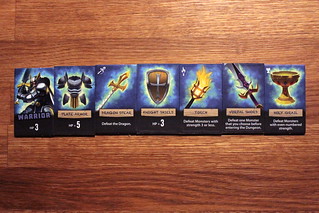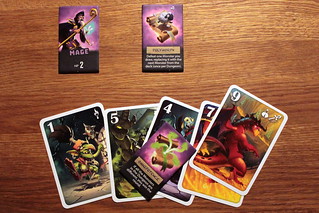| Strategy | Luck |
|---|---|
| Interaction | Components & Design |
| Complexity | Score |
Aaaah, the hero has arrived. Very good, we’ve been waiting for you. Welcome to the Dungeon! Have a seat while we prepare your adversaries. You can hang your gear in the corner over there. No? Well, you can’t blame a dungeon master for trying, can you? What? No, I’m sorry, you can not bring your whole party, the vampire is scared of crowds.
That speech is given many times a day in the dungeon foyer of Iello’s Welcome to the Dungeon, a game with elements of bluffing and push-your-luck by Masato Uesugi that is now available in English in Iello’s mini game series. As a mini game, Welcome to the Dungeon is naturally quick and light on the rules, you can learn it in two minutes and play it in half an hour or less, depending on everyone’s luck.
Although it is a game about heroes and dungeons, it is nothing like a dungeon crawler type game. There is no game board to move the hero across, there is only one hero in play at a time instead of one per player, and that hero starts with a full set of equipment. And none of that low quality stuff you get as a reward for clearing the giant rats of the inn’s basement, either. These heroes start with Vorpal Swords, Rings of Power or spells called Omnipotence. Before each round, you pick one of the four heroes – Warrior, Mage, Barbarian or Rogue – and put his hero tile on the table with all his equipment next to it.
Then you start making his job harder. Taking turns, each player draws one card from the monster stack and decides what to do with it. Option one is to simply place it face down in the dungeon. When the hero finally enters he’ll have to fight it, and you are now the only person to know this specific monster is waiting for him. The other option is to put the monster in a discard pile instead of the dungeon, also hidden from the other players, and remove a piece of gear from the adventurer. At least potentially, that is the more dangerous option because heroes’ gear is powerful stuff. Some of it only increases the hero’s hit points, but all heroes have gear with more interesting effects. For instance, the Warrior’s Vorpal Sword and the Rogue’s Vorpal Dagger let you name one type of monster before you enter the dungeon and the weapon will kill that monster – very useful when you put the dragon, the strongest monster in the game, in the dungeon yourself and know he’s lurking there. As another example, the Mage has a Polymorph spell that lets him replace a monster card from the dungeon with a new card from the monster stack. Other gear items defeat all monsters with strength three or less, or all monsters whose Strength is an even number. Lots of good stuff, and taking the right piece of gear away is often more devastating than adding another monster to the pile.

The only reason you want to make the hero’s life hard is that you hope you won’t have to accompany him into the dungeon. But someone will have to. On your turn, instead of drawing a card and doing bad things, you can simply pass. Nothing bad can happen to you after that cowardly move, but you can’t get back into the current round, either. The last player left after everyone else passed has to enter the dungeon with whatever equipment the hero has left and defeat the monsters. That part of the adventure is even easier: one by one, the brave (or stupid) hero turns the monster cards in the dungeon. If he has any equipment that can defeat that monster it is simply discarded. Without such equipment, the monster is still discarded, but the hero loses its strength from his hit points. If he defeats all the monsters and still has at least one hit point left, the hero wins and takes a success cards. Two of those are enough to win. If he loses, he turns his player aid from the white side to the brown side to show that. Lose again and you’re out of the game. Normally, the player elimination would be a big turn-off for me, but in a game that is as quick as Welcome to the Dungeon you won’t sit by the sideline for long, so that’s okay.
Welcome to the Dungeon makes it clear from the start that it’s a mini game, so we can’t complain about its lack of complexity. You have to do exactly two things: push your luck, because if pass too early you give someone else a too easy time, and bluff, because you want other players to pass before things get too hard. Bluffing well is essential; if you can’t convince people to pass early you’ll get to a point where you play one more card, all the other players pass one by one and you’re stuck with your own mess. Welcome to the Dungeon is a very pure game that way, with nothing at all distracting from its core mechanic. It won’t keep you going for a whole evening of playing – unless you add alcohol – but it’s very good to pass a bit of time, be it waiting for another game to finish or, in a pinch, while stuck in traffic. Being a mini game, you can take it everywhere and set it up almost everywhere. You never know when you’re going to need a game, so take Welcome to the Dungeon along just in case.









